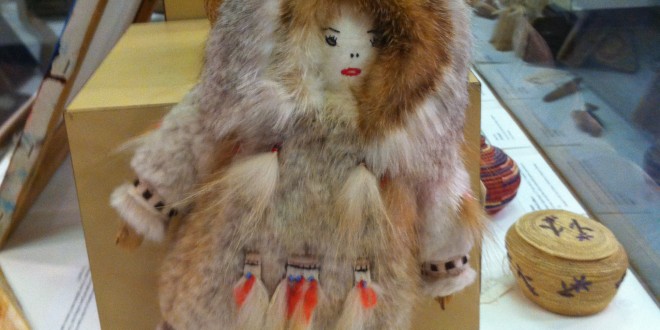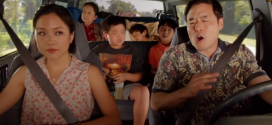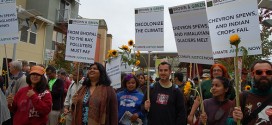By Tamara Treichel
Upon posting on Facebook that I, the quintessential urbanite and downtown D.C. native, was headed for Alaska, two of my Facebook friends were quick to associate the trip with Alaska’s former governor. “In search of Sarah Palin?” one of my Facebook friends quipped.
Nope.
Instead, I was in search not only of the breathtaking, pristine nature of Jon Krakauer’s Into the Wild, but also of America’s “original Asian Americans.” While my Chinese husband was called upon to repair an oil platform in Cook Inlet, I had carte blanche to explore the Kenai Peninsula.
My original plan was to do a bit of hiking, but the locals discouraged me from doing so alone due to bear muggings. So instead I decided to explore the Kenai Peninsula from the comfort of our rental car and try to learn as much as I could in the space of a week about the state’s history and people, especially its native populations – Alaska’s “original Asian Americans,” who, it is commonly believed, had crossed the Bering land bridge to the North American continent from Asia thousands of years ago.
I would strike gold as my trip proved to be a perfect balance between learning passively from museum exhibits and learning actively by talking to the locals, some of whom were “native” themselves.
For those interested in Alaska’s native peoples, Kenai’s Visitor and Cultural Center in downtown Kenai and the Anchorage Museum are valuable resources. Kenai’s Visitor Center features an array of artifacts from Kenai’s Russian and Dena’ina Indian past – the Denai’na are native Athabascan Indians who live on the Kenai Peninsula and whose traditional livelihoods depended on fishing and hunting.
At Kenai’s Visitor Center, I admired a beautiful blood-red Dena’ina bag made out of bear intestine and a beaded moose hide jacket with mukluks (boots). The center also features several movies on the Dena’ina way of life (language, medicine, cuisine, etc.).
One movie there explained how until recently, local native populations were still unofficially discriminated against in schools with spitting and name-calling, and how today’s Dena’ina ingeniously combined traditional skills with modern technology.
The Dena’ina language itself was introduced as being one of the most grammatically complex, and I was surprised to learn that only in the 1970’s had efforts started to preserve this language because to lose a language is to “lose cognitive diversity.”
The Visitor’s Center was merely a prelude to what awaited me in the Anchorage Museum, where I visited the first major exhibit ever presented about the Dena’ina people. Over 160 artifacts were on display: a waterproof bear gut parka, a feather headdress worn by shamans, caribou skin socks, a fire bag to carry fire-making materials and burning embers. The Denai’na wasted nothing, and today’s “disposable society” could learn a lot from this people. My personal favorite was a moose mock-up – you could press buttons on the moose’s body parts (for example, “rump”) and listen to the Dena’ina term for it.
I learned that the Dena’ina lived mostly independently next to Alaska’s white settlers during the late nineteenth and early twentieth centuries, even blending native and Christian beliefs and practices. However, they had become a minority in their own homeland by 1920 as their hunting and fishing grounds were depleted.
Here, one of the best travel tips I can give you is not only to bury yourself in museum exhibits, but also to approach as many locals as you can as they exude history themselves.
I discovered that Alaska’s non-natives had a symbiotic relationship with their native American neighbors – for example, I visited a Caucasian artist in his studio near Kenai city, and the artist used native elements in his lithographs and had made a collage titled The Shaman as a nod to Alaska’s native population, frugally using ravens’ wings and animal bones.

Photo by Tamara Treichel
I was also lucky to meet two Alaska’s native inhabitants in person. Far less numerous than Caucasians, they are yet still very much a presence in Alaska, and I would catch glimpses of them when I went shopping or saw their silhouettes in cars. For me, a Washington, D.C. native, this was a very different experience, because the closest you could get in D.C. to the “original Asian Americans” was probably Smithsonian’s National Museum of the American Indian.
I met a warm and witty Yup’ik Eskimo who doubled as the priest of a Russian Orthodox church in downtown Kenai called “Father Thomas,” who had obviously assimilated himself to Christianity to such an extent that he was the leader of a small parish. Father Thomas showed me around the small church which bore witness to Kenai’s Russian past, and although he very rarely leaves his parish, he welcomes visitors from all over the world.

Photo by Tamara Treichel
Moreover, at the Anchorage Museum, a young Denai’na woman with nimble fingers was fashioning delicate earrings out of birch bark and beads while answering visitors’ questions about the Dena’ina exhibit. So I chatted a bit with her about what I had learned from my museum visits.
When I asked her about discrimination, she replied, “Discrimination is not as prevalent as it used to be.” However, she added that sadly prejudice was still rampant, as some native Americans are still associated with homelessness and alcoholism.
As regards the Dena’ina language, she said she spoke some, but wasn’t fluent. Her mother, too, wasn’t fluent, having been discouraged from using her native language at her boarding school, a common phenomenon.
“We have less than a 100 native speakers left,” the young Denai’na woman told me. “It’s scary.” (The University of Alaska, Fairbanks website not too long ago put the Denai’na speakers at a mere 50 out of a total population of 1000).
Yet the Dena’ina are hanging on. “We are still here,” the museum’s special exhibits curator, himself Dena’ina said on the Anchorage Museum website about the Denai’na exhibit. “This is how we live. This is what we value.”
I felt immensely fortunate to have caught glimpses of the indigenous Dena’ina culture. May the Dena’ina and Alaska’s other “original Asian Americans” live long and prosper.
 Asian Fortune Your source for all things Asian American
Asian Fortune Your source for all things Asian American




One comment
Pingback: Time for AFC to find a new path for flagging Champions League